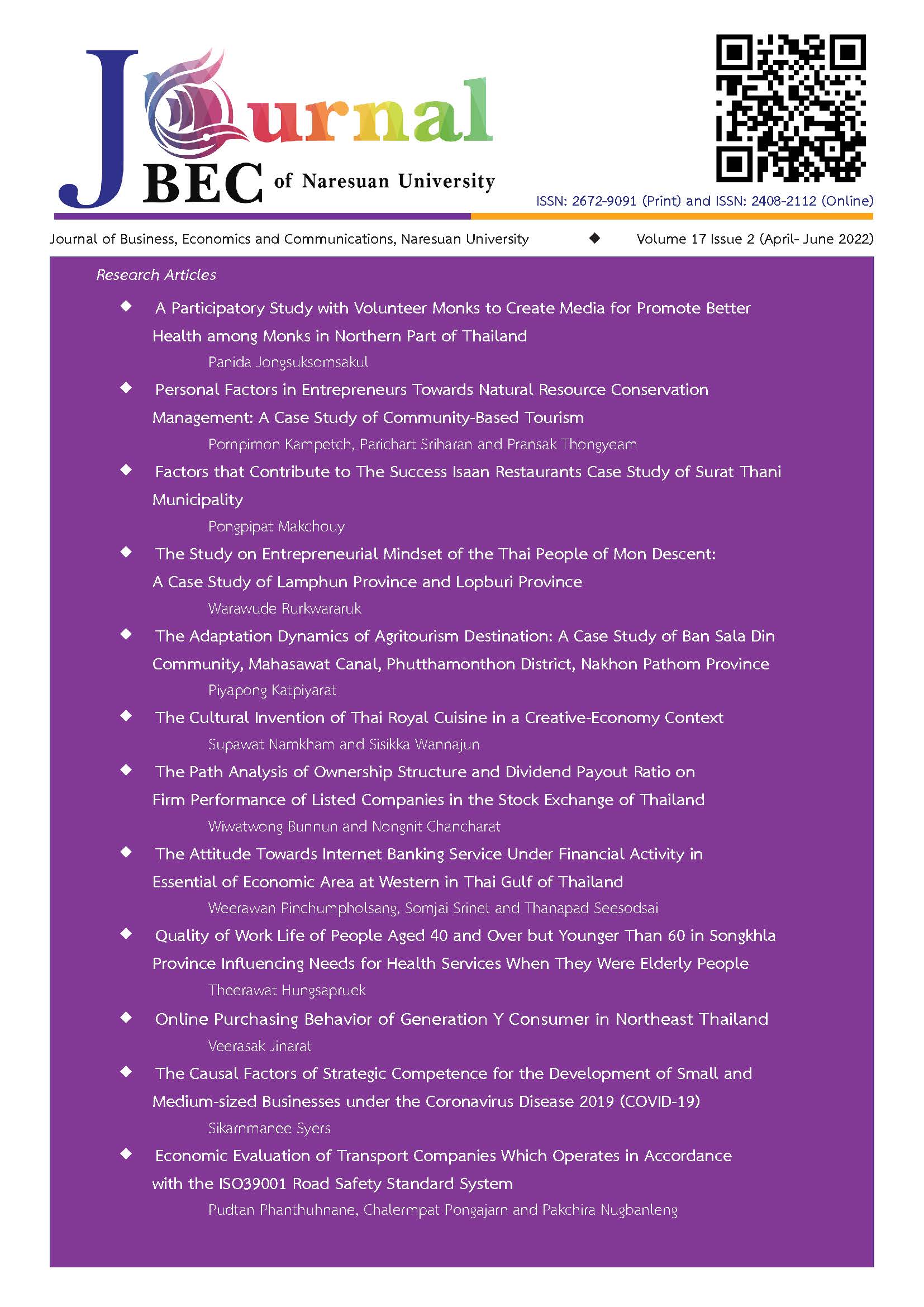Online Purchasing Behavior of Generation Y Consumer in Northeast Thailand
Main Article Content
บทคัดย่อ
This quantitative research is intended to study online purchasing behavior of generation Y consumers in northeast of Thailand, including the mean comparative and rational relationship analysis for further development. The researcher developed a 23-item questionnaire and collected from 348 volunteers. The statistics analysed were frequency, percentage, means, standard deviation, t-test, F-test, MANOVA and linear regression analysis. The results present that the mean of consumer behavior and intention behavior are high for all components. Besides, the mean difference of consumer behavior and intention behavior also contributed statistically significant difference at .05, separated by age, education, occupation, time-used for online media and online purchasing product. Importantly, this research demonstrates that the development of online purchasing for generation Y, the online entreprenure must offer the diversity of mass virtual products with the information to ensure the trust, confidence, and perceived usefulness in purchasing products.
Article Details

อนุญาตภายใต้เงื่อนไข Creative Commons Attribution-NonCommercial-NoDerivatives 4.0 International License.
เอกสารอ้างอิง
Ajzen, I. (1991). The theory of planed behavior. Organizational Behavior and Human Decision Process, 50(2), 179-211.
Chang, H. H. and Wang, H. W. (2011), "The moderating effect of customer perceived value on online shopping behaviour", Online Information Review, 35(3), 333-359.
Chen, J. and Shen, X. (2015). Consumers’ decisions in s-commerce context: An empirical investigation. Decision Support Systems, 79, 55–64.
Dailynews. (November 27, 2020). Stunned! The Gen Y group smelting the money. Dailynews, 9-11
Ellison, N., Heinio, R. and Gibbs, J. (2006). Managing Impressions Online: Self-Presentation Processes in the Online Dating Environment. Journal of Computer-Mediated Communication, 11(2), 415-441.
Garcia, J. M., De Lamonica Freire, O. B., Santos, E. B. A. and Andrade, J. (2020). Factors affecting satisfaction and loyalty to online group buying. Determinants of Loyalty to Online Group Buying, 27(3), 211-225.
George, J. F. (2004). The Theory of Planned Behavior and Internet Purchasing. Internet Research, 14, 198-212.
Gounaris, S., Dimitriadis, S. and Stathakopoulos, V. (2010). An examination of the effects of service quality and satisfaction on customer behavioral intentions in e-shopping. Journal Service Marketing, 24 (2-3), 142-156.
Gopal, R. and Jindoliya, D. (2016). Consumer buying behavior towards online shopping: a literature review. International Journal of Information Research and Review. 3, 3385-3387.
Hsu, M., Chuang, L. and Hsu, C. (2014). Understanding online shopping intention: the roles of four types of trust and their antecedents. Internet Research, 24(3), 106-139.
Hu, Y., Sun, X., Jing, Z., Zhang, X., Luo, F. and Huang, L. (2009). University student behavioral intention model of online shopping based on TAM. International Conference on Information Management, Innovation Management and Industrial Engineering, 625-628.
Jinarat, V. (2021). Modern Research Methodology, Ubon Ratchathani: Yong Sawat Inter Group Publishing, pp. 86-96
Juthanan B. (July 7, 2020). Spend' must think carefully about the needs before making a Decision. Dailynews variety, 6.
Kim, J. (2012). An empirical study on consumer first purchase intention in online shopping: integrating initial trust and TAM. Electronic Commerce Research, 12(2), 125-150.
Li, Y. (2016). Empirical study of influential factors of online customer repurchase intention. International Business, 8(3), 48-60.
Lim, Y. J., Osman, A., Salahuddin, S. N., Romle, A. R. and Abdullah, A. (2016). Factors influencing online shopping behavior: The mediating role of purchase intention. Procedia Economic and Finance, 35, 401-410.
Muda, M., Mohd, R. and Hassan, S. (2016). Online Purchase Behavior of Generation Y in Malaysia. Procedia Economics and Finance, 37, 292-298
Nakcharoen, C. (July 7, 2020). Consumer perspective after COVID-19. Dailynews variety, 12
Orapin, L. (2009). Factors influencing internet shopping behavior: A survey of consumer in Thailand. Journal of Fashion Marketing and Management, 13(4), 501-513.
Tasente, T. (2020). Twitter Discourse Analysis of US President Donald Trump. Social Media political communication, 2, 67-75. Thairat. (November 22, 2020). Proactively sell products online to fight the virus. Thairat, 7.
Vakulenko, Y., Oghazi, P. and Hellstrom, D. (2019). Innovative framework for self-service kiosks: Integrating customer value knowledge. Journal of Innovation & Knowledge, 4(4), 262-268.
Venkatesh, V., Morris, M.G., Davis G.B. and Davis, F.D. (2013). User acceptance of information technology: towards a unified view. MIS Quarterly, 27(3), 425-478.
Walsh, G., Schaarschmidt, M. and Ivens, S. (2017). Effects of customer-based evidence from gender moderation on perceived risk and relational outcomes: Empirical evidence from gender moderation in fashion retailing. Journal of Product and Brand Management, 26(3), 227-238.
Zhang, L., Liu N, Ma X, and Jiang, L. (2013). The transcriptional control machinery as well as the cell wall integrity and its regulation are involved in the detoxification of the organic solvent dimethyl sulfoxide in Saccharomyces cerevisiae. FEMS Yeast Res, 13(2), 200-18.
Zhou, L., Dai, L. and Zhang, D. (2007). Online shopping acceptance model-A critical survey f consumer factors in online shopping. Journal of Electronic Commerce Research, 8(1), 41.


